The Huawei Ascend Mate 7 Review
by Andrei Frumusanu on December 2, 2014 8:00 AM EST- Posted in
- Smartphones
- Huawei
- Mobile
- Ascend Mate 7
- HiSilicon
Display
With the Ascend Mate 7, Huawei introduces a JDI-manufactured IPS-Neo screen. The advantage of the IPS-Neo technology is that it provides better viewing angles and contrast ratio due to a change in the manufacturing process which allows for the the liquid crystal molecules to be uniformly aligned on the glass substrate.
Indeed, the viewing angles of the Mate 7 are much improved and I'd say it's one of the best in terms of LCD displays. Contrast ratio has also considerably gone up as we'll see in a bit.
The Mate 7 display offers lots of promise, but let's see if it holds up with our objective measurement tests. We use an X-Rite i1Pro 2 as our measurement hardware, in conjunction with SpectraCal's CalMAN software suite and our own workflow to be able to get an accurate display characterization.

The Mate 7 ends up at 484cd/m² in terms of brightness. It's plenty of bright for all but the most sunny days. Only direct sunlight reflectance may pose an issue.
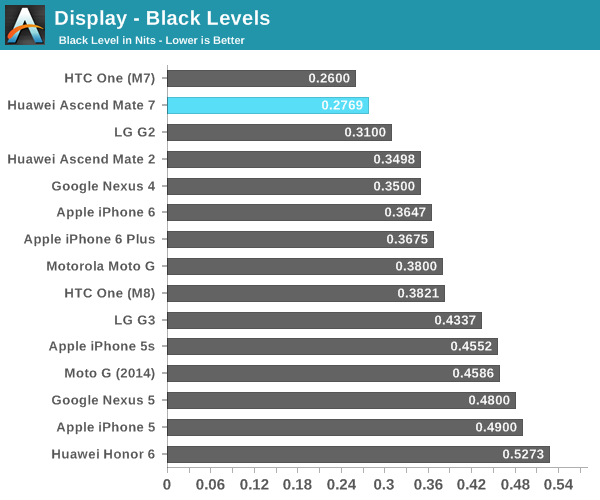
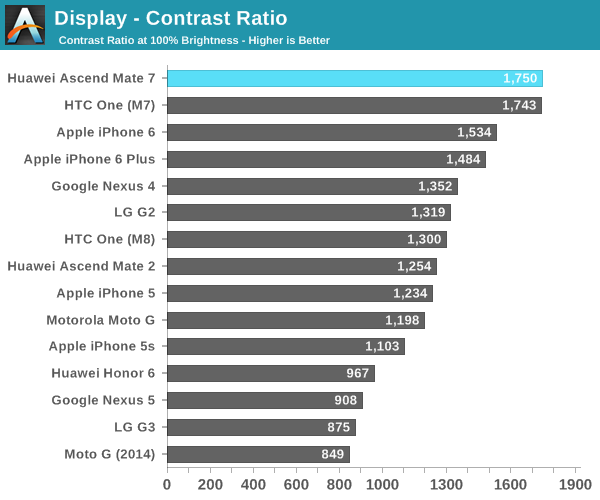
In the black levels and respectively the contrast ratio is where we see the IPS-Neo screen perform extremely well. For an LCD screen, this is one of the deepest blacks I've come to meet in a device. The HTC One M7 seems to be the only other device to come near it, but that was at a lower brightness point with dynamic contrast.
The Mate 7 is able to achieve a 1750:1 contrast ratio, putting it at the top of the LCD pack. Only AMOLED displays are able to outperform this figure due to their ability to avoid any light emission on a per-pixel level.
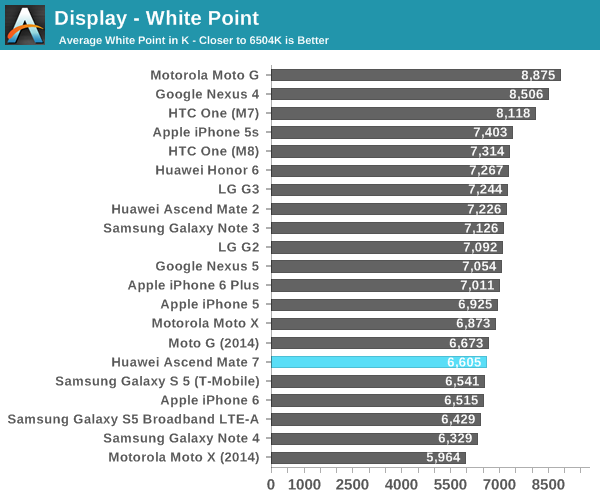
In terms of colour temperature, the Mate 7 performs again quite well while hitting 6605K. This time Huawei seems to have aimed for 6500K instead of colder colours as on the Honor 6. If you still prefer the more colder and blue-dominated whites, Huawei as retained the colour temperature slider under the display settings which allows you to adjust the tone of the display to your own preference.
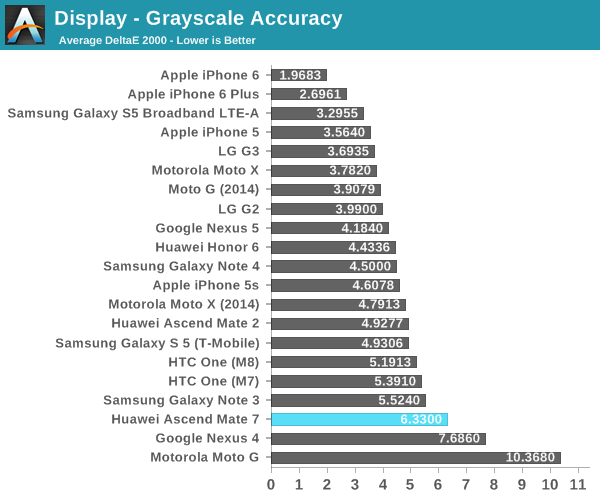
While the colour temperature figure seems to be quite good, under further investigation we see that there's a problem. Our grayscale accuracy test shows that there's much too much green at all grayscale levels. In fact, this is actually clearly visible on the device as we see a slight green tint. Gamma reaches an acceptable 2.11, still a bit off a perfect 2.2. Due to the green tint of the device the grayscale dE2000 ends up at 6.33, much worse than any device released in the last 18 months, and above the average perceivable threshold of 5.
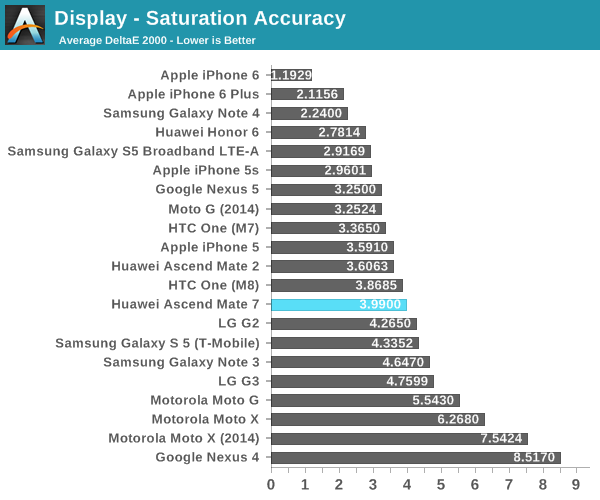
Looking at the saturation accuracy graph, we see again an overabundance of green. It looks like the whole spectrum is pulled slightly towards green, which results in a whole offset of all measured colourpoints. This is a pity as the display seemed to be quite well calibrated in terms of saturation compression. The end result is that we end up with a meager dE2000 of 3.99. While this is much less worse than the grayscale measurements, it's not too bad, for example, it performs better than this year's G3.

Our Gretag MacBeth test is a measurement of accuracy of several commonly used colours. The Mate 7 ends up with a respectable dE2000 of 3.88 here. We again find that the score is merely thwarted by the green-shift of the display, prohibiting this display to enter the group of outright excellently calibrated devices such Samsung's and Apple's newest models.













72 Comments
View All Comments
Laststop311 - Tuesday, December 2, 2014 - link
Wish we could have some american phones with battery life like this.arsjum - Tuesday, December 2, 2014 - link
Andrei,Any chance you'll be reviewing Galaxy Note 4 exynos version?
Andrei Frumusanu - Tuesday, December 2, 2014 - link
I've been working on the article for 2 weeks, it's coming.DanD85 - Tuesday, December 2, 2014 - link
Thanks for reviewing this Huawei phone, anandtech. These days, Chinese manufacturers have much more interesting devices compare to the old players. Anandtech has been my favorite tech review site for more than 10 years and you guy offer the most in depth review on the whole interweb. Keep up the great work!Sicariase - Wednesday, December 3, 2014 - link
Seriously Andrei, thanks for this review. I've been tossing up between the note 4 and this for a couple of weeks, and just decided to get the huawei (didn't think the differences were massive from other reviews) when this review came out. You've potentially saved me from a world of disappointment.Bondurant - Wednesday, December 3, 2014 - link
As with other reviews on this site, the problem in this review is that there is no corresponding reference to real life usage. Just lots of numbers but for example why not a real life gaming comparison between Mate 7 and Note 4 ? NAND performs horrible in benchmarks but if in real life there is barely any noticeable change, than does the benchmark score even matter ? How about comparing the photos with other 13MP IMX214 phones ? Also frustrating i found is there is no explanation as to what exactly is the cause of poor battery performance of Mate 7, is it the fault of GPU or their modem or that it does not use a amoled screen like Note 4 ? Is it a fixable issue with rom updates ?Ofcourse ideally Huawei could have simply thrown in some Qualcomm and so on like Samsung does, but it prevents the development of Hauwei's own innovations and implementations. HiSilicon from its last year K3V2 to this years Kirin 925, there is huge improvement and they are already releasing their 64bit chip kirin 930 this December and a Kirin 950 in June.
Andrei Frumusanu - Wednesday, December 3, 2014 - link
Basically the cause of bad battery life is that power consumption of the Kirin SoC is too high - I've explained this in the review of the Honor 6 where I took an in-depth look into the chip.Bondurant - Wednesday, December 3, 2014 - link
But a comparison between Honor 6 and Samsung S5 (both the Qualcomm and Exynos version) battery life don't show Kirin SOC having such suspected high battery drain problem, although yes you did mention ways battery life could have been improved but nothing to say of a huge problem.The case with Mate 7 on the other hand with 1000mAh more battery than Honor 6 does seem weird that the battery life improvements are only marginal.
Andrei Frumusanu - Monday, December 8, 2014 - link
I did point out that the Honor 6 is less efficient than competing devices.johnny_boy - Thursday, December 4, 2014 - link
Are you serious? I own an Honor 6 and I'm getting two days of battery life under normal usage (YouTube, Gmail, Gcal, pdf reading, etc.) Under light usage I can get 2.5-3 days. This is with wifi on and auto half brightness, which I find comfortable. I'm even using Firefox for Android with adblock for browsing which is likely worse on the battery than Chrome. Some REALISTIC battery life numbers would be pretty useful--like how long were you getting under what you deem light/normal/heavy usage?